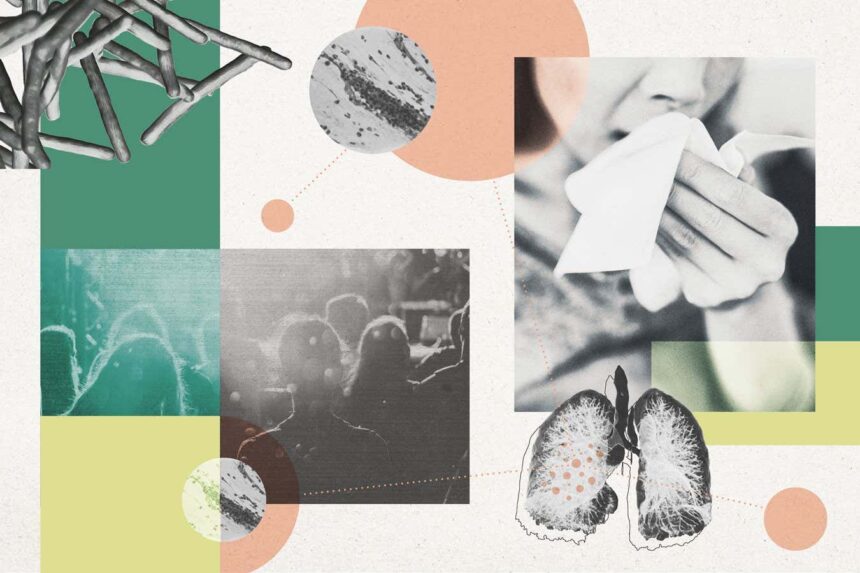
We are starting to understand why the bacteria behind tuberculosis is so good at infecting people
Adobe Stock/Ryan Wills
When we look back over the history of infectious diseases, it’s the explosive pandemics that grab our attention. Cholera and plague terrify us with their swift destruction of cities and the paralysis they cause across whole nations, while the devastation brought about by quieter diseases can be easy to overlook.
And perhaps no disease has wreaked more havoc under the radar than tuberculosis. Creeping from person to person, slowly killing its victims over the course of years, Mycobacterium tuberculosis has caused more cumulative suffering than any flashier pathogen.
And it continues to wreak havoc. While smallpox was eradicated in the 1970s and very few people now die from plague, tuberculosis is continuing its deadly rampage. Roughly a quarter of all people alive today have been infected with M. tuberculosis. In 2023 alone, tuberculosis killed 1.2 million people – about twice the number of deaths caused by HIV or malaria.
“The fact that TB still kills and sickens so many people is an outrage, when we have the tools to prevent it, detect it and treat it,” the World Health Organization’s Tedros Ghebreyesus said in 2024.
Besides lack of political will, there is another reason for TB’s success, one that has to do with the microbe itself. M. tuberculosis has evolved into an astonishingly adept human pathogen. And one of its greatest skills is its ability to fly through the air.
The hunt for TB’s cause
It has taken thousands of years for humanity to appreciate those skills. About 3300 years ago, physicians in India wrote down some of the oldest known observations of tuberculosis. About 2400 years ago, Hippocrates observed how people with phthisis – the ancient Greek term for the disease – were continually “spitting crude matters”. But he believed phthisis was inherited, rather than produced by a strain of bacteria.
In the 1600s, when European anatomists started performing autopsies of TB victims, they noticed distinctive lumps in the lungs, which they called tubercles. In the early 1800s, the doctor René Laënnec invented the stethoscope and used it to listen in on the rattling lungs of people with tuberculosis, creating the first modern diagnosis of the disease.
As for TB’s cause, Laënnec followed Hippocrates: he believed some people inherited a weak constitution from their ancestors. Grief or unrequited love could shock their frail bodies into a diseased state.

A false-colour image of Mycobacterium tuberculosis (gold)
CNRI/SCIENCE PHOTO LIBRARY
But in 1882 the physician Robert Koch proved a germ was responsible. He isolated rod-shaped bacteria from sputum coughed up by people with TB.
Koch’s discovery of M. tuberculosis soon persuaded the medical world that the disease was infectious rather than hereditary. He speculated that people expelled the bacteria from their bodies with coughs, which then fell and dried to dust, and this could later get stirred up into the air to be breathed in by others. “Thus, it is probably that tubercle bacilli are usually inhaled on dust particles,” wrote Koch.
The belief that TB lurked in dust led to calls for housewives to keep their homes clean. Spittoons appeared in homes, offices and factories so that TB victims could have a safe place to hurl their spit. But the idea that TB spread in dust was nothing more than a speculation.
Soon, researchers began experiments to see how M. tuberculosis actually moved from host to host. One involved putting seven rabbits in a sack and having a cow sick with tuberculosis wheeze into it. “On taking the rabbits out of the sack, they seemed much exhausted,” wrote Myron Blaine, a physician in New York, in 1887.
Despite repeating the experiment seven times, Blaine found that none of the rabbits contracted tuberculosis during their time in the sack, prompting him to conclude “the germ is not given off in the expired air”.
More rigorous experiments in the 1890s also cast doubt on dust as the vehicle for TB. One effort, at the Institute of Hygiene in Breslau – then a part of Germany, now the city of Wrocław in Poland – involved spreading sputum from TB patients on boards and cloth. After it dried, researchers puffed air across the surfaces to lift up the hypothesised bacteria-laced dust. The team, led by Robert Koch’s close friend Carl Flügge, found that guinea pigs placed nearby rarely caught tuberculosis as a result.
Perhaps, Flügge thought, TB didn’t depend on dust at all. Perhaps people could simply exhale the germ.

In the 1930s, people with TB were treated with bed rest in the open air
Fox Photos/Getty Images
His assistants refitted some of his labs for a much bigger experiment, clearing out the furniture and placing Petri dishes on the floor. People with tuberculosis stepped into the rooms and proceeded to cough and speak. Flügge’s assistants gathered up the dishes to see if anything grew in them.
By tracking which of the dishes bloomed with M. tuberculosis, the experiment demonstrated that the bacteria could travel several metres through the room. What’s more, Flügge could wait for hours after his volunteers left before putting dishes on the floor, and yet he could still catch the microbes.
Flügge inferred that TB didn’t spread in dust. Instead, the germs could float out of people’s mouths and then drift long distances through the air. “The dissemination of germs through the air has been underestimated,” he concluded.
Many doctors at the time found floating TB hard to imagine, but starting in the early 1930s, William and Mildred Wells spent a quarter of a century proving this was true.
The husband-and-wife team worked out how microbes – including those that cause TB and measles – can stow away in tiny droplets that we release even when only quietly breathing. Air currents can keep these aloft for hours, and in an unventilated room, other people can readily breathe them in.
This is true of many pathogens, but the Wellses found that M. tuberculosis is particularly remarkable, being carried by droplets deep into the lungs, where it invades immune cells called macrophages and starts multiplying.
The pair battled for their entire careers to persuade doctors of the dangers of airborne infection. After Mildred died in 1957, William went on to carry out one final experiment to make the case. He and his colleagues set up a special tuberculosis ward in a hospital in Baltimore. The air from the ward got pumped into an empty room on the floor above, where it flowed into a cage full of guinea pigs. One by one, the guinea pigs grew tubercles in their lungs. Only this carefully controlled experiment, carried out over the course of years, could reveal what earlier experiments had missed.
After William died in 1963, public health experts largely dismissed the concerns he and Mildred had raised about airborne infections – a tragic mistake that left the world unprepared for the covid-19 pandemic. But the couple did manage to persuade the scientific community that tuberculosis, at least, was airborne. And that is one of the traits that makes M. tuberculosis so successful as a pathogen, especially in the modern age. In poorly ventilated indoor spaces, it can drift through the air for hours, waiting for its next victim to take a breath.
TB’s evolutionary origins
Researchers are now investigating the evolutionary origins of M. tuberculosis to understand how it became so adept at airborne infection. For decades, tuberculosis experts generally agreed that we originally got the disease from domesticated cows, which suffer their own form of TB, but this hypothesis fell apart with the discovery of tuberculosis-ravaged bones from people who lived 10,000 years ago. Found in Syria, these victims of TB were hunter-gatherers, not cattle herders. The discovery suggested that tuberculosis was already circulating among people before cattle were domesticated. Genetic analysis has subsequently revealed that TB jumped from people to cows, and not the other way round.
M. tuberculosis may have evolved instead from something similar to Mycobacterium canettii, one of its closest relatives. This bacterium can’t infect lungs and doesn’t spread from one person to another. It probably isn’t a full-time pathogen; instead, it dwells as a free-living organism somewhere in the environment of East Africa, where it may live in the ground and feed on plants.
This suggests that tuberculosis may have come into being through an extraordinary evolutionary transformation, somehow adapting from living in the ground to moving from lung to lung.
In some ways, living in the soil may have pre-adapted the forerunners of M. tuberculosis for life as airborne pathogens that invade our respiratory system. The perpetual threat of being devoured by amoebae that rove around through the soil led them to evolve the ability to survive getting swallowed up by these single‑celled predators, and even to feed on them from the inside once captured. They then multiplied and burst out of the amoeba cells.
When M. tuberculosis became a human pathogen, it carried on with this same strategy, but now it used it in our lungs, growing inside macrophages instead of amoebae, destroying the immune cells that swallowed them.

Tuberculosis causes scarring (green) in the lungs, as this X-ray shows
DU CANE MEDICAL IMAGING LTD/SCIENCE PHOTO LIBRARY
But the success of tuberculosis also depended on new adaptations that allowed M. tuberculosis to spread efficiently through the air. The surface of the bacteria is coated with a protein that tickles the nerve endings in the human airway. That trigger causes people to issue a distinctive cough, sending out plumes of droplets.
When M. tuberculosis escapes a host, it still faces a dangerous journey before it can start replicating again. Once the droplet leaves the warmth of a human body and floats through the air, it gets cold and the concentration of oxygen within it soars. These changes can damage a microbe’s proteins, threatening its survival.
A recent experiment suggests that M. tuberculosis deploys a complex defence to stay alive as it moves through the air. Researchers observed that almost half the genes in the microbe’s genome are essential to its survival inside a droplet.
Scientists have yet to figure out what most of those genes specifically do, but for now, one thing is clear: M. tuberculosis didn’t emerge overnight through a single, simple mutation. To give it wings, nature carried out a genomic overhaul.
Carl Zimmer is a columnist for The New York Times and his latest book is Air-Borne: The hidden history of the life we breathe.
Topics:








